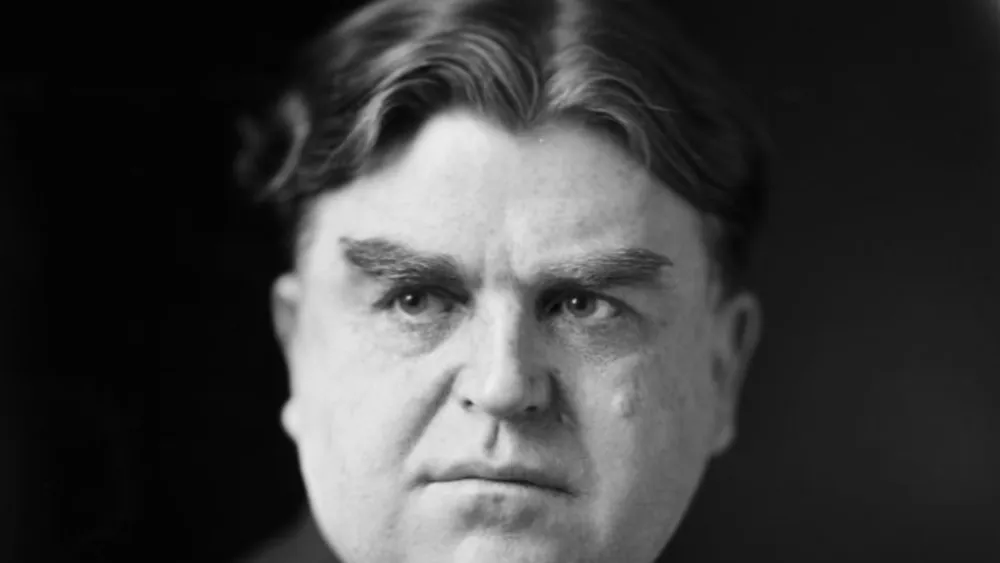John L Lewis led the United Mine Workers of America (UMW) from 1920 to 1960, significantly impacting coal mining history.
He spearheaded the founding of the Congress of Industrial Organizations (CIO) during the Great Depression, focusing on the rights of industrial workers.
Despite being a Republican, Lewis played a crucial role in Franklin D. Roosevelt’s 1936 victory and later diverged on FDR’s foreign policy in 1940.
An influential labor leader, he secured high wages but faced criticism for nationwide coal strikes during World War II. Lewis, an iconic figure, left a lasting legacy, selecting Tony Boyle as his successor in 1963.
Early Life and Entrance into Union Activism
John Llewellyn Lewis, born in or near Cleveland, Lucas County, Iowa, to Welsh immigrants Thomas H. Lewis and Ann Watkins, hailed from a company town built around a coal mine. Raised in the Reorganized Church of Jesus Christ of Latter Day Saints (RLDS), he absorbed social justice and abstinence teachings. Attending high school in Des Moines, Lewis entered the workforce at the Big Hill Mine in Lucas at 17.
In 1906, he became a delegate to the United Mine Workers (UMW) national convention, marking the start of his involvement in union activities. Despite unsuccessful ventures in politics and business, including a run for mayor in 1907, Lewis persisted in coal mining. Relocating to Panama, Illinois, he was elected president of the UMW local in 1909. Samuel Gompers, head of the AFL, recognized Lewis’s potential, hiring him as a full-time union organizer in 1911. Lewis’s role as an organizer and troubleshooter took him across Pennsylvania and the Midwest. Therefore, they focused on coal and steel districts.
John L Lewis: Struggles within the United Mine Workers
John L. Lewis assumed a pivotal role within the United Mine Workers of America after serving as its statistician and vice president. In 1919, he became the acting president, leading the first major coal union strike on November 1, 1919, with 400,000 miners participating.
Faced with an injunction from President Woodrow Wilson, Lewis prioritized compliance over confrontation, emphasizing, “We cannot fight the Government.” His election as UMWA president in 1920 marked the beginning of his dominance over the country’s largest and most influential trade union.
The Clash Between Socialism and Lewis’s Pragmatic Approach
During the 1920s, socialist sentiments among coal miners globally attracted Communist influence, with attempts to control UMWA locals.
Lewis favored cooperation over radical ideologies and centralized control, suppressing leftist movements within the union. So, Amid fierce internal strife, Lewis expelled radicals, forming the National Miners’ Union.
Despite criticism for his authoritative style and purges, Lewis maintained loyalty from his followers, securing wage increases and improved safety for miners, even during economic downturns.
A skilled orator and strategist, Lewis orchestrated a five-month strike in 1921 to safeguard wartime wage gains. In a bid for broader leadership, he challenged Samuel Gompers for the American Federation of Labor (AFL) presidency in 1921 but was unsuccessful.
Following Gompers’ death in 1924, Lewis’s associate, William Green, assumed the AFL presidency.
Shaping the Destiny of Coal Miners Amid the Great Depression
During the Great Depression, John L Lewis adeptly navigated the intricate political landscape. Initially supporting Republican Herbert Hoover, he shifted allegiance to quietly favor Democrat Franklin D. Roosevelt in 1932.
By 1936, he contributed over $500,000 by strategically rallying considerable union support behind Roosevelt’s reelection. Leveraging roles on the Labor Advisory Board and the National Labor Board, Lewis advanced miners’ wages and reduced competition.
Aligning with FDR’s popularity, he successfully initiated a membership drive, capitalizing on diverse ethnic groups’ shared faith in Roosevelt.
Lewis’s influence culminated in the passage of the Guffey Coal Act in 1935, later replaced by the Guffey-Vinson Act in 1937, favoring miners.
Rejecting socialism, Lewis advocated for competitive capitalism, envisioning a stabilized coal industry through union influence and ushering miners into a prosperous era during challenging economic times.
John L Lewis: Political Shifts and Controversies
In the 1940 election, John L. Lewis shifted allegiance, backing Wendell Willkie over Roosevelt, sparking debates on his motives. Criticized by union peers, Lewis resigned from the CIO presidency but retained UMWA control. Pre-Pearl Harbor, he staunchly opposed U.S. entry into WWII, rejecting the draft and aligning with the CIO’s anti-militaristic stance. Moreover, Lewis’s anti-intervention stand persisted, joining conservatives against Roosevelt.
Post-Pearl Harbor, he reversed, supporting FDR for national unity. In 1942, Lewis withdrew UMWA from CIO, violating pledges, prompting Roosevelt’s intervention, damaging public perception, and affecting wartime production.
John L. Lewis’s Impact on the 1950s Mining Landscape
In the 1950s, John L. Lewis secured periodic raises and benefits for miners and championed the creation of the first Federal Mine Safety Act in 1952.
Attempting to stabilize a declining industry, he used collective bargaining to set standards, often forcing small operators out of business. Furthermore, mechanization led to job losses, and non-union operations persisted.
Despite his autocratic leadership in the UMWA, the Landrum–Griffin Act 1959 compelled reforms, ending the trusteeship practice.
Retiring in 1960, Lewis left behind a dwindling, highly-paid membership. His chosen successor, W. A. Boyle continued Lewis’s dictatorial style.

Post-Retirement Honors and Legacy
After retiring from the UMWA in 1960, John L. Lewis received the Presidential Medal of Freedom from President Lyndon B. Johnson on September 14, 1964.
The citation praised him as an “eloquent spokesman of labor” who championed free trade unions within a robust free enterprise system.
1965 he earned the inaugural Eugene V. Debs Award for his dedication to Industrial Unionism.
Retiring to his Alexandria, Virginia, home, the Lee–Fendall House, Lewis passed away on June 11, 1969.
Even former rivals, like Reuben Soderstrom, acknowledged Lewis’s legacy of improving conditions for coal miners. Furthermore, he is interred at Oak Ridge Cemetery in Springfield, Illinois.
Life Lessons from John L. Lewis
John L. Lewis, a towering figure in labor history, teaches us the enduring importance of moral leadership.
From his early days in coal mining to shaping the destiny of miners during economic challenges, Lewis displayed resilience and strategic insight.
His ability to adapt politically, advocate for workers’ rights, and navigate complex landscapes reflects the value of pragmatic leadership.
Moreover, Lewis’s legacy highlights how steadfast dedication to workers’ well-being and a commitment to progress can leave a lasting impact on industries and enhance the lives of those who rely on them.











